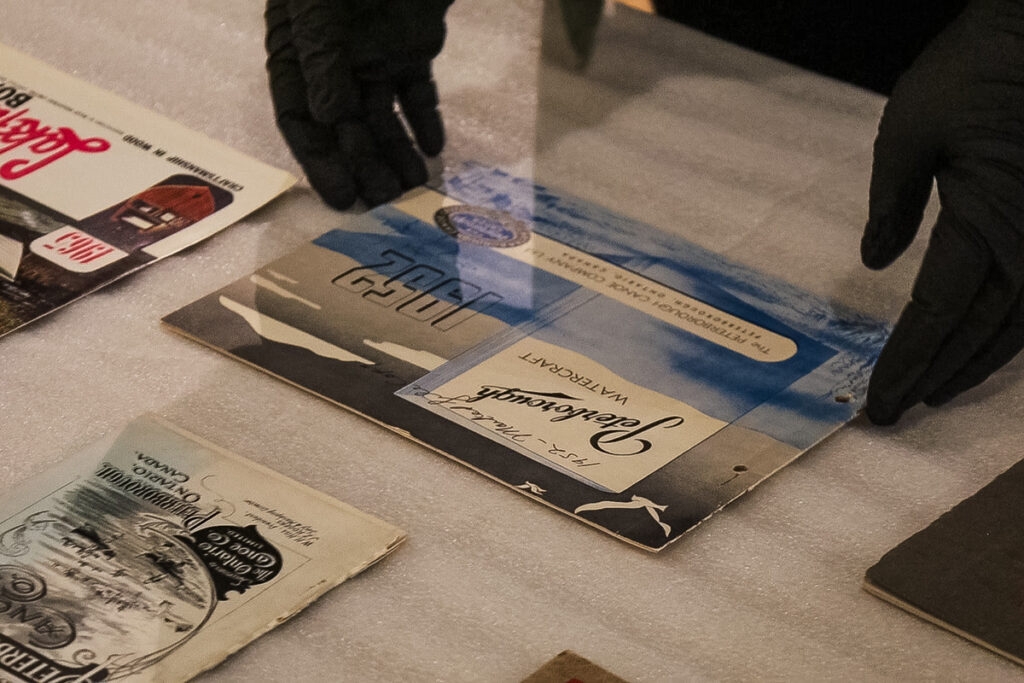The Collection
Founded on the collection of the late Professor Kirk Wipper and established in Peterborough, Ontario, in 1997, The Canadian Canoe Museum cares for more than 600 canoes, kayaks and paddled watercraft, with over 100 on display in our Exhibition Hall. Together, they span the country from coast to coast to coast, representing many of the major watercraft traditions of this country and even the world.
Not just a collection of watercraft, the Museum also stewards a collection of paddles and paddling accessories, small artifacts including canoe and kayak models, an archival collection that includes photos, postcards and canoe manufacturing history, and a reference library and a rare books collection.
This unique collection is as diverse as the people, stories, and makers behind the watercraft! In 2013, the Senate declared The Canadian Canoe Museum and its collection a cultural asset of national significance.
In our new museum, we have created a very special home for the artifacts that are not on display in the Exhibition Hall. The new 20,000-square-foot Collection Hall on the first floor of the new museum is dedicated solely to caring for these watercraft and sharing more of the collection for generations to come.
Our new Collection Hall enables:
- Integrated, On-Site Storage: Providing 20,000 square feet of seamlessly integrated and accessible storage space for the collection.
- Inspiring Visibility: Drawing in visitors with a captivating view from the Atrium and Mezzanine through magnificent 23-foot high glass windows, inviting everyone to witness the diversity and depth of the collection.
- Enhanced Artifact Care and Stewardship: The Collection Hall will care for the collection with Class “A” Museum Environmental Control standards, nurturing these artifacts with the utmost respect.
- Honouring of Cultural Practices: Embracing traditional care practices, the Collection Hall sets a precedent for the rest of the Museum in accommodating practices like smudging ceremonies and fostering an inclusive and respectful environment.
- Open Doors, Shared Stories: For the first time, the collection will be available to view via tours and appointments, facilitating increased engagements, connections, and understanding.
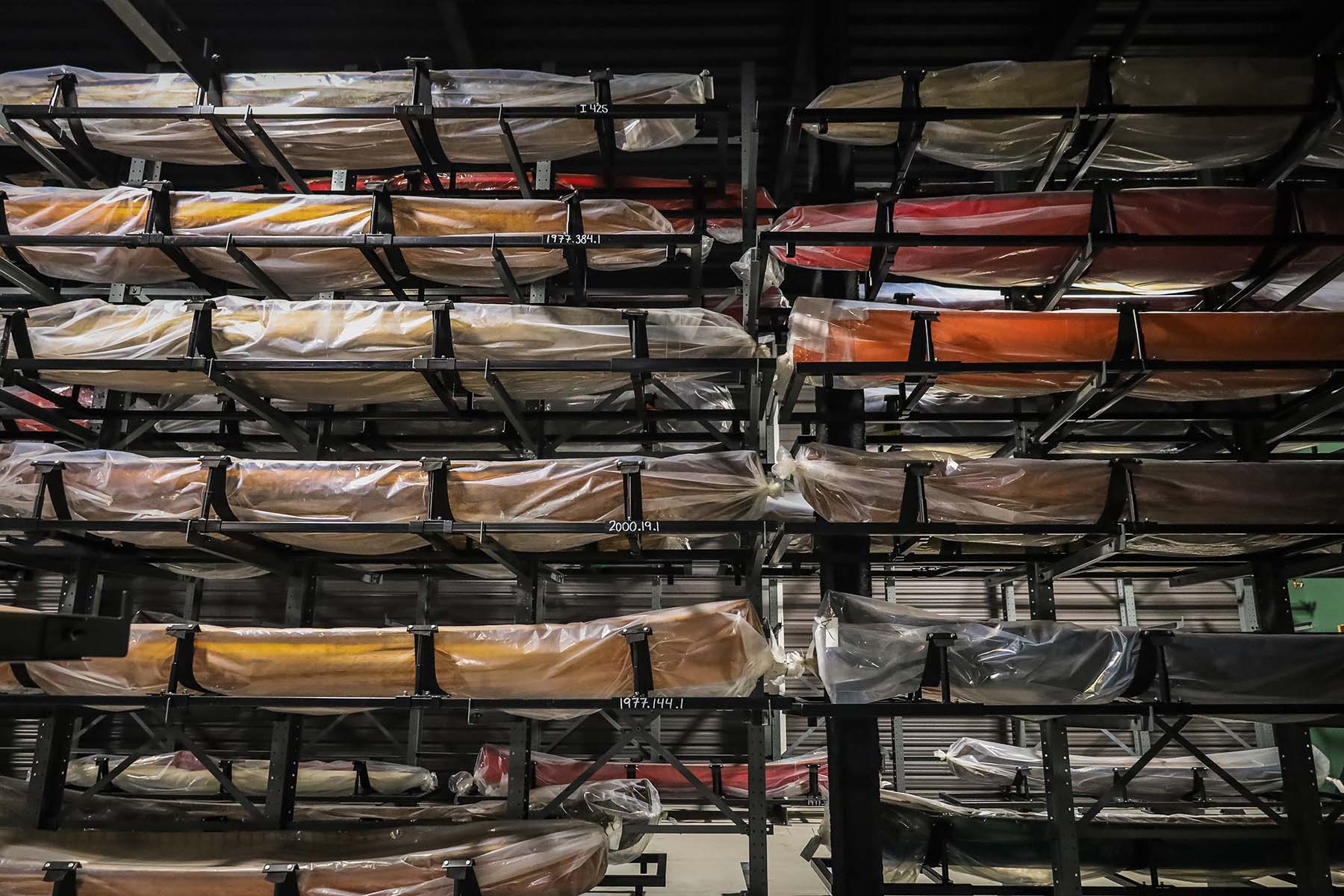
Donate an Artifact
Donate an artifact to The Canadian Canoe Museum and help us share the incredibly diverse stories and legacy of paddled watercraft.
Learn more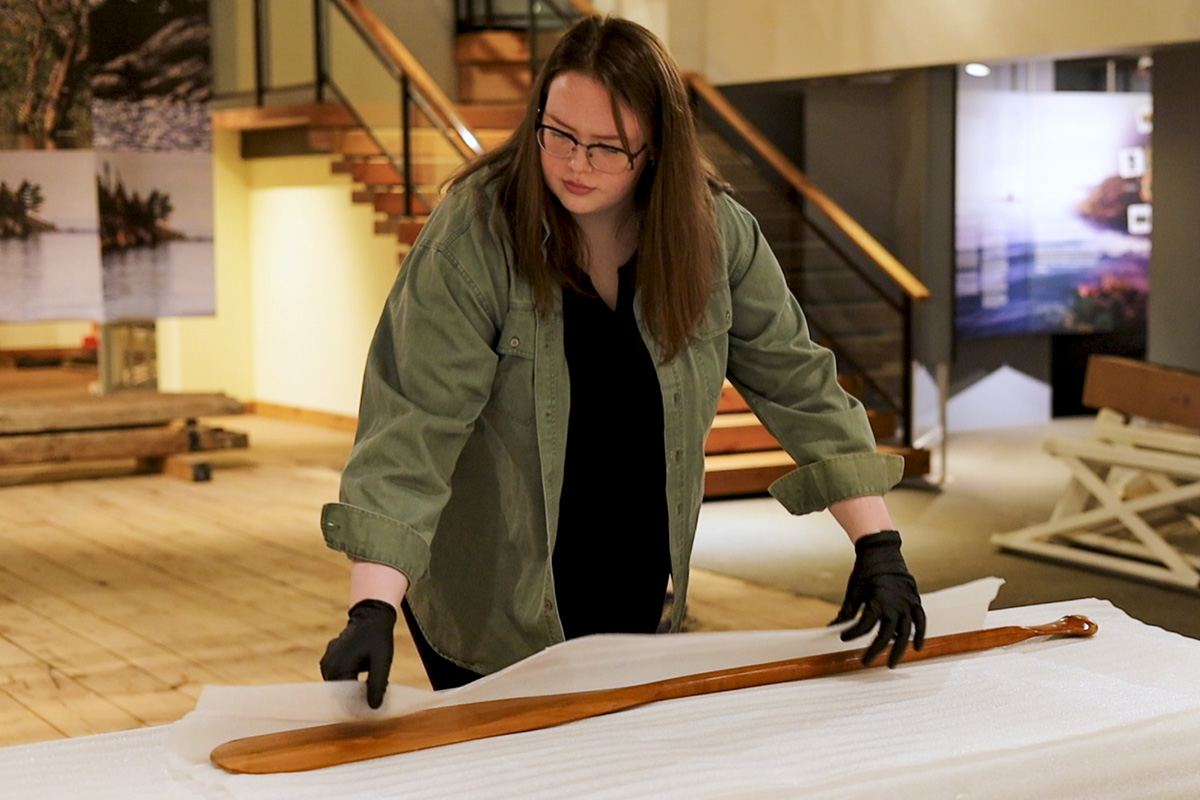
Deaccessions & Repatriations
The collection is carefully curated to ensure alignment with our values and mission. Learn about the process for deaccessioning or repatriating artifacts.
Learn moreCollection Preview
Haida Dugout by Victor Adams (1977.1.1)
This Haida dugout was commissioned in 1967. It was built by Victor Adams at Masset on Haida Gwaii from a single cedar log. No such canoe had been built within living memory, and Adams was mentored by Adam Bell, an Elder. Construction took three years and was completed in 1971, along with paddles and a bailer. The canoe, painted black, was decorated by Adams and his daughter, Alice Montjoy, with an eagle design at the bow of the canoe. The canoe arrived at Ontario Place in Toronto in 1972, and after a ceremonial welcome, a group of campers paddled through the Trent-Canal system to Camp Kandalore. The building of this canoe preceded the remarkable resurgence of Haida canoe-building tradition. To quote Victor Adams, “It was a hard job, but I liked the result.” His son and grandson are now building traditional Haida canoes.

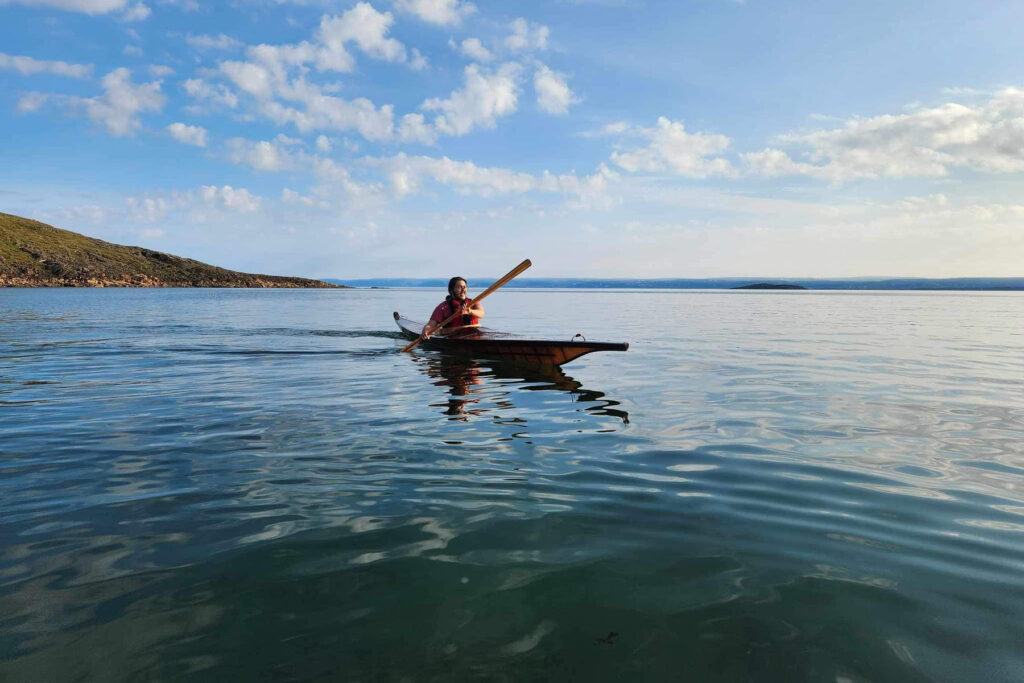
Uqqurmiut Qajaq (Kayak) (2023.4.1)
This qajaq (kayak) was built in 2023 for the Canadian Canoe Museum by the Qajakkut Society in collaboration with local Elders and knowledge holders in Iqaluit. This Uqqurmiut (People of Southern Baffin Island) qajaq is one of a handful built in recent years in Iqaluit. This qajaq represents a new generation’s interpretation of their own regional style.
Bill Mason’s Prospector (1999.16.1)
Bill Mason’s 16-foot red Prospector canoe is possibly the most famous canoe in Canada. It arrived at the Mason home on Meech Lake, north of Ottawa, from the builder, Chestnut Canoe Company in Fredericton, New Brunswick, in the spring of 1973. From that moment, the canoe was used in many of Bill Mason’s projects, his instructional films on canoeing, his books, The Path of the Paddle, The Song of the Paddle, and his last epic film, Waterwalker. It was frequently used on Bill’s month-long solo trips on the north shore of Lake Superior, on family trips in Algonquin Park, and on trips down the Pukaskwa River, north of Superior, where the canoe ribs were damaged. Bill danced at his son’s wedding with the canoe on his shoulders, and his wife, Joyce, scattered Bill’s ashes from it in 1989. It was donated to the Canadian Canoe Museum after their daughter, Becky, performed a canoe ballet on the Trent-Severn Waterway in Peterborough in 1999.

Photo Credit: Michael Cullen
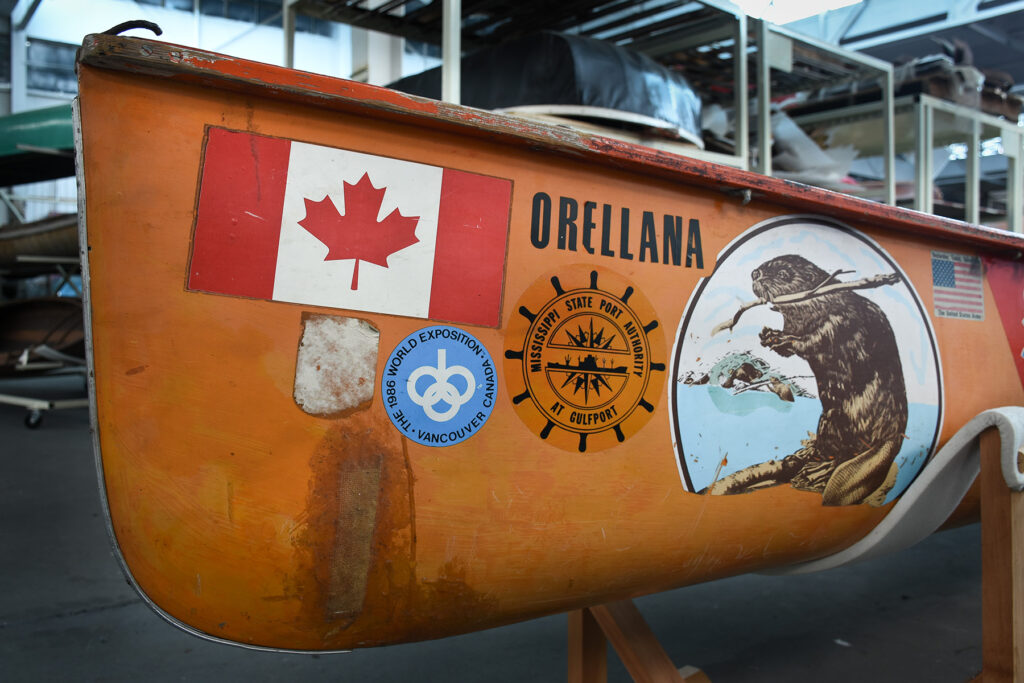
Photo Credit: Margo Pfeiff
The Orellana (2002.5.1)
The Orellana, a battered fibreglass canoe covered with decals, was recognized in the Guinness Book of Records in 1986 for the longest canoe journey – 12,000 miles. In this canoe, Don Starkell set out from Winnipeg, Manitoba, with his sons, Dana, and for part of the trip, Jeff. Beginning with upstream travel on the Red River, they reached the Mississippi and the Gulf of Mexico. Travel along the coast of Mexico was fraught with danger from ocean currents and surf landings, to which were added soldiers and bandits along the coast of Honduras and Columbia. After much-needed professional repairs in Venezuela, they reached the Orinoco River, where 1000 miles of upstream paddling connected them with the Rio Negro and the Amazon, finishing at Belem at the mouth of the Amazon.
Indigenous Collections
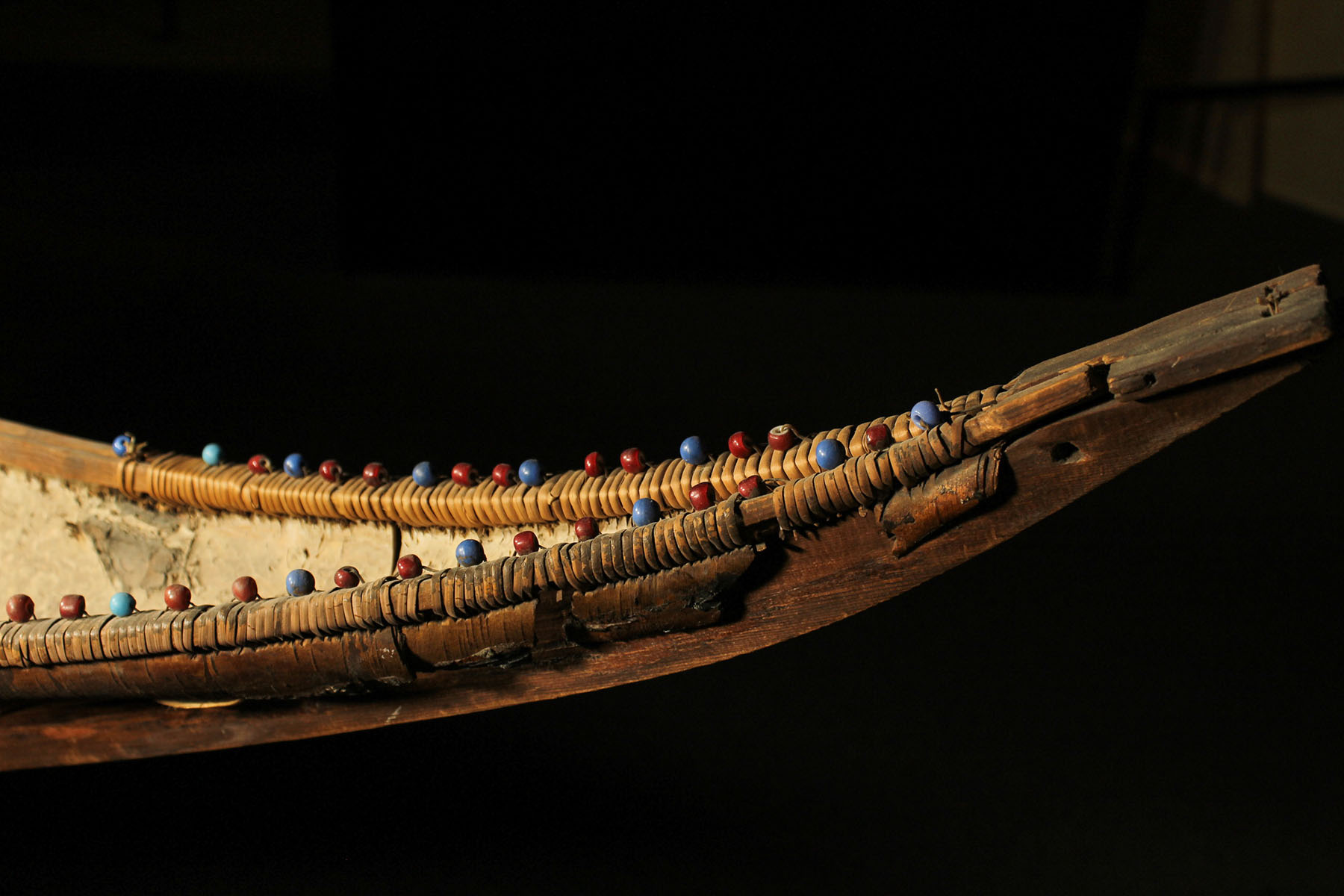
The Canadian Canoe Museum cares for over 600 watercraft, primarily from North America but also from around the world. The collection spans across cultures, both Indigenous and non-Indigenous, and represents a rich diversity of stories and histories. While the history of Indigenous collections in museums remains controversial, The Canadian Canoe Museum supports and prioritizes the accessibility of collections and cultural belongings to Indigenous Peoples.
Access to Collections
In 2022, the Canadian Museums Association released new standards for implementing the United Nations Declaration on the Rights of Indigenous Peoples (UNDRIP) and supporting Indigenous self-determination in museums. This includes “The recognition that Indigenous Peoples have intellectual sovereignty over all material created by or about them. This includes the right to know about these belongings and connected traditional knowledge or intangible heritage, as well as the right to control access to these.” It also recognizes “Indigenous Peoples as rights holders when it comes to accessing and stewarding their belongings. This requires co-development of methods of access and care of belongings that are defined by the Indigenous communities themselves. This may mean repatriation or stewardship.”
The Canadian Canoe Museum is committed to providing Indigenous rightsholders access to their cultural belongings through onsite, accessible collections storage.
United Nations Declaration on the Rights of Indigenous Peoples (UNDRIP)
The United Nations Declaration on the Rights of Indigenous Peoples (UNDRIP) is a comprehensive international instrument on the rights of Indigenous Peoples. It establishes a universal framework of minimum standards for the survival, dignity and well-being of the Indigenous Peoples of the world. It also elaborates on existing human rights standards and fundamental freedoms as they apply to the specific situation of Indigenous Peoples.
UNDRIP is the principal framework upon which the Truth and Reconciliation Commission’s (TRC) Calls to Action are based. The Calls to Action by the TRC are aimed at a range of institutions, laws, and programs affecting Indigenous Peoples and legislation aimed at its implementation. UNDRIP is an expansive declaration consisting of 46 Articles.
In 2016, Canada formally endorsed the UNDRIP nine years after they initially voted against it. This led to the development and eventual enactment of the United Nations Declaration on the Rights of Indigenous Peoples Act, which came into force on June 21st, 2021.
The new standard for UNDRIP in museums is that Indigenous Peoples have intellectual sovereignty over all material created by or about them, as defined in UNDRIP Article 31. This includes the right to know about these belongings and connected traditional knowledge or intangible heritage, as well as the right to control access to these.
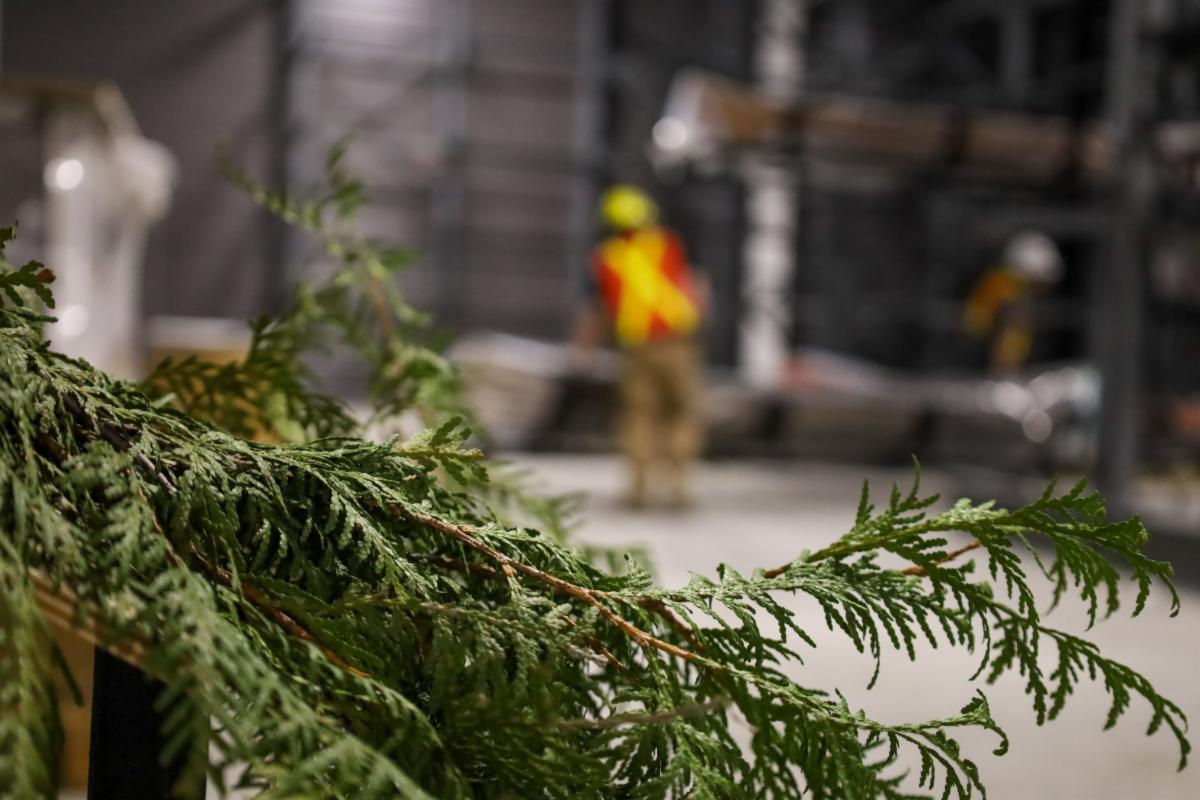
Traditional Care of Collections
The Canadian Canoe Museum recognizes that the care and preservation of cultural belongings goes beyond physical conservation outlined in the Canadian Conservation Institute’s ‘Agents of Deterioration‘. The Museum works to decolonize collections care and stewardship by welcoming ceremonial practices within the collection.
This may include, but not be limited to, smudging, food burning, or other protocols and ceremonies as defined by the source community relating to a cultural object or belonging within The Canadian Canoe Museum’s care.
The Knowledge and Research Centre
The Knowledge and Research Centre is home to the Archives Storage and the Library and Research Rooms. The Centre provides space for properly caring for a growing collection of rare books, maps and other archival assets, including film and video, photographs and recorded oral histories. The Knowledge and Research Centre also provides a comfortable and quiet environment for the recorded documentation of oral histories.
To request access to our library or archival collection or otherwise make use of this space, please connect with our curatorial team.
Contact Our Curatorial Team